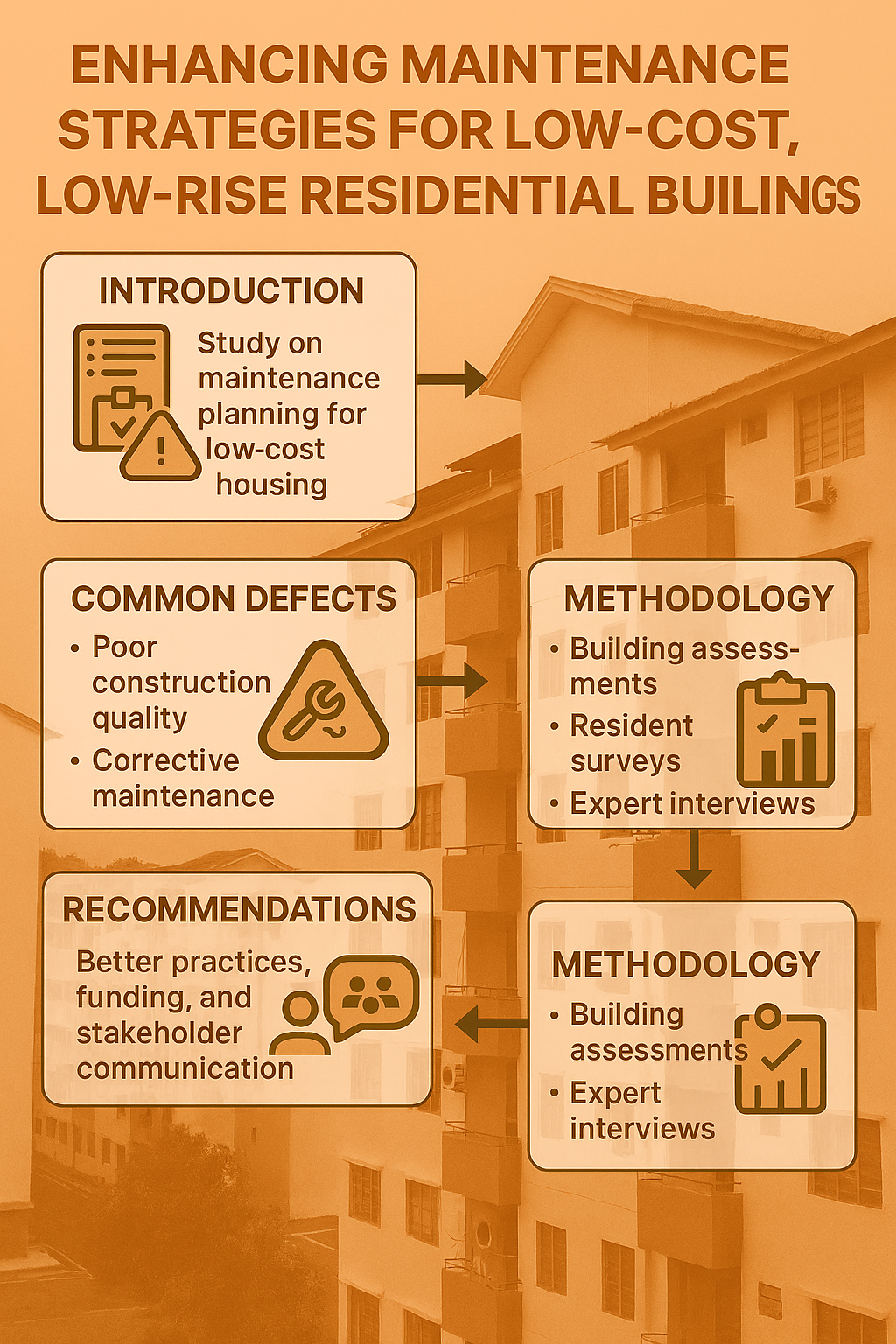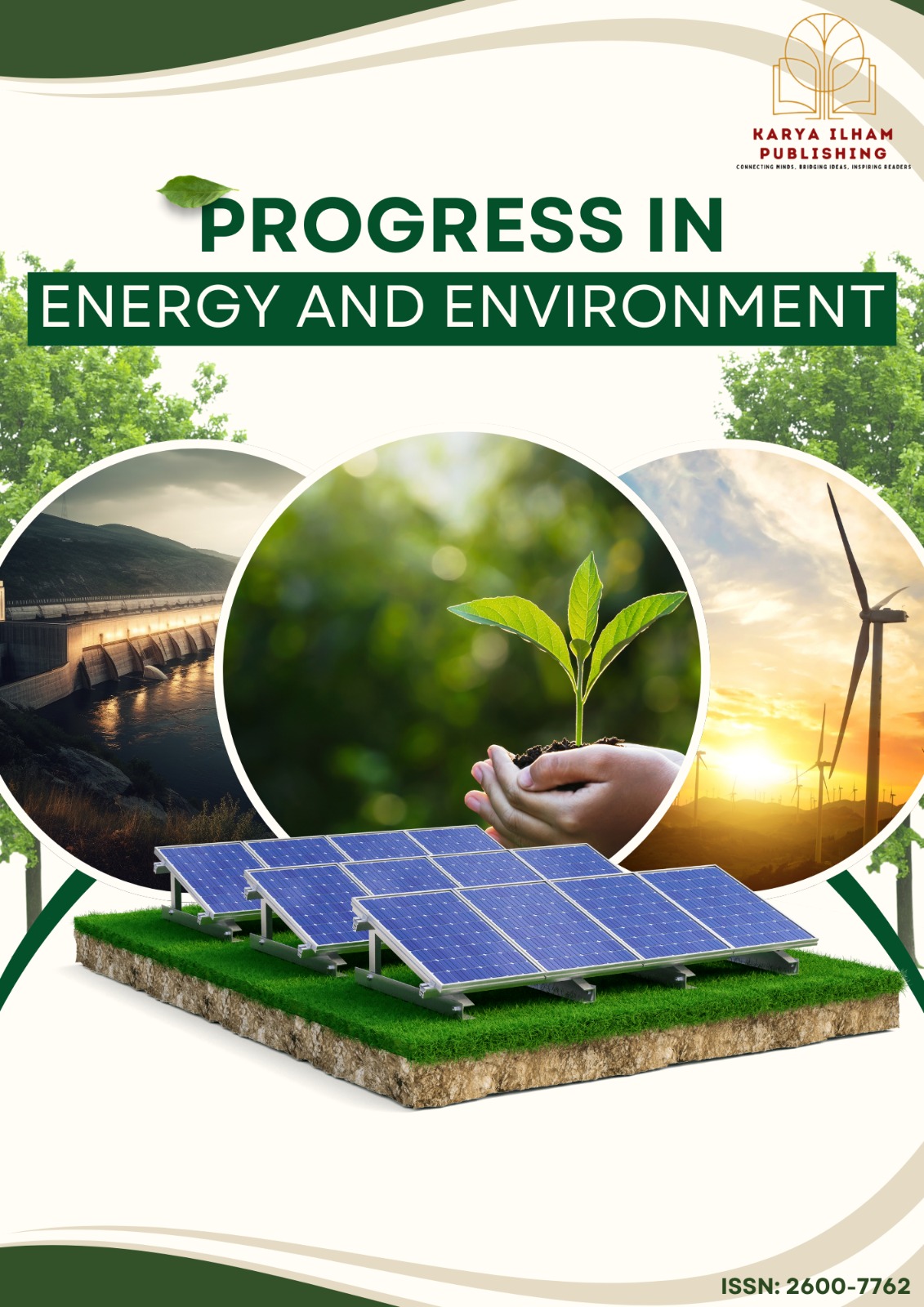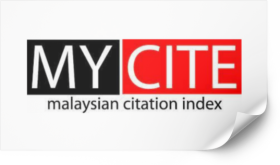A Conceptual Paper on the Effective Approach of Maintenance Practices for the Low-Cost Low-Rise Residential Buildings in the Northern Region, Malaysia
Keywords:
Maintenance, Low-Cost Low Rise Residential, Building Condition, Building DefectAbstract
This research focuses on improving maintenance strategies for Malaysia's low-cost, low-rise residential buildings. Challenges include poor construction quality, reliance on corrective maintenance, and insufficient financial resources due to inefficient fee collection. These issues increase breakdowns, higher costs, and reduced building performance. The study aims to enhance the appropriate building maintenance planning in low-cost, low-rise residential buildings by assessing building conditions, identifying challenges, and recommending solutions. A mixed-method approach involves building condition assessments, resident and management surveys, and expert interviews to gather comprehensive insights. The findings will emphasise the importance of better construction practices, adequate funding, and improved stakeholder communication to ensure effective maintenance.
References
[1] A.A.A. Shuhaimi, M.M. Osman, N.S. Rabe, S.M.S.K. Alhabshi, and D. Aripin, Low-Cost Strata Maintenance Issues and Cost Impact. Planning Malaysia: Journal of the Malaysian Institute of Planners 21(2) (2023) 262–275. https://www.planningmalaysia.org/index.php/pmj/article/view/1276/957.
[2] R.M.W. Horner, M.A. El‐Haram, and A.K. Munns, Building Maintenance Strategy: A New Management Approach. Journal of Quality in Maintenance Engineering 3(4) (1997) 273–280. https://doi.org/10.1108/13552519710176881.
[3] A.S. Ali, S.N. Kamaruzzaman, R. Sulaiman, and Y.P. Cheong, Factors Affecting Housing Maintenance Cost in Malaysia. Journal of Facilities Management 8(4) (2010) 285–298. https://doi.org/10.1108/14725961011078990.
[4] M.M.F. Ashraf and N.S. Nikmat, Common Defects in Public Institutional Buildings in Malaysia. Journal of Sustainability Science and Management 18(7) (2023) 45–59. https://doi.org/10.46754/jssm.2023.07.003.
[5] E. Plebankiewicz and J. Malara, Analysis of Defects in Residential Buildings Reported during the Warranty Period. Applied Sciences 10(7) (2020) 6123. https://doi.org/10.3390/app10176123.
[6] S. Yacob, A.S. Ali, and C.P. Au-Yong, Establishing Relationship Between Factors Affecting Building Defects and Building Condition. Journal of Surveying, Construction and Property 10(1) (2019) 31–41. https://ejournal.um.edu.my/index.php/JSCP/article/view/18607/10143.
[7] H.K. Wang, G.H.T. Ling, and X. Shi, Collective Action Components of Low-Cost Housing: an Empirical Analysis using Ostrom's SES Framework. Property Management 40(3) (2022) 388–408. https://doi.org/10.1108/pm-07-2021-0053.
[8] N. Dzulkifli, N.N. Sarbini, I.S. Ibrahim, N.I. Abidin, F.M. Yahaya, N. Zainab, and N. Azizan, Review on Maintenance Issues toward Building Maintenance Management Best Practices 44 (2021) 102985. https://doi.org/10.1016/j.jobe.2021.102985.
[9] A. Lateef, Olanrewaju, and H.J.A. Lee, Analysis of the Poor-Quality in Building Elements: Providers’ Perspectives. Frontiers in Engineering and Built Environment 2(2) (2022) 81–94. https://doi.org/10.1108/febe-10-2021-0048.
[10] M.A.O. Mydin, N.H. Ja’afar, N. Norazman, M.A. Zaidi, and M.N.M. Nawi, Appraisal of the Aetiology and Pathology of Soil Settlement-Related Building Defects and Failures Journal of Advanced Research in Applied Sciences and Engineering Technology 50(1) (2024) 286–307. https://doi.org/10.37934/araset.50.1.286307.
[11] J. Japok, M.A.O. Mydin, and R. Omar, Identification of Structural and Non-Structural Defects of Load-Bearing Wall Systems in Low Rise Buildings. Journal of Advanced Research in Applied Mechanics 120(1) (2024) 171–188. https://doi.org/10.37934/aram.120.1.171188.
[12] F. Faqih and T. Zayed, Defect-based Building Condition Assessment. Building and Environment 191 (2021) 107575. https://doi.org/10.1016/j.buildenv.2020.107575.
[13] M.C. Dejaco, F.R. Cecconi, and S. Maltes, Key Performance Indicators for Building Condition Assessment. Journal of Building Engineering 9 (2017) 17–28. https://doi.org/10.1016/j.jobe.2016.11.004.
[14] N. Norazman, S.N.A.M. Nashruddin, andA.I. Che-Ani, Exploring the Factors Influencing Building Sustainability of Low-Cost Low-Rise Residential towards User Satisfaction. Journal of Facilities Management 22(5) (2024) 949–974. https://doi.org/10.1108/JFM-08-2022-0089.
[15] M. Damlakhi, Evaluation of Low-Rise Neighborhoods and High-Rise Neighborhoods in The Context of New Urbanism. Social Science Development Journal 7(29) (2022) 199–212. https://doi.org/10.31567/Ssd.551.
[16] A. Ebekozien, A.-R. Abdul-Aziz, and M. Jaafar, Comparative Analysis of Low-Cost Housing Policies in Malaysia and Nigeria. International Transaction Journal of Engineering, Management, & Applied Sciences & Technologies 8(3) (2017) 139–152. https://doi.org/10.22452/jscp.vol11no1.1.
[17] A. Ebekozien, A.R. Abdul-Aziz, and M. Jaafar, Unravelling the Encumbrances in the Low-Cost Housing Computerised Open Registration System in Malaysia’s Major Cities. Property Management 39(3) (2019) 325–343. https://doi.org/10.1108/pm-08-2019-0048.

Downloads
Published
Issue
Section
License
Copyright (c) 2025 Progress in Energy and Environment

This work is licensed under a Creative Commons Attribution-NonCommercial 4.0 International License.











